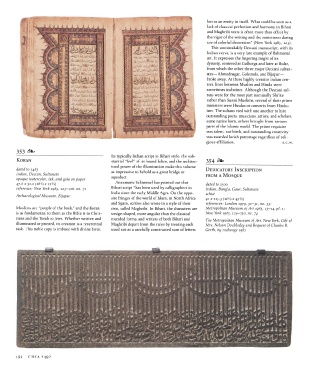Page 495 - Art In The Age Of Exploration (Great Section on Chinese Art Ming Dynasty)
P. 495
but as an entity in itself. What could be seen as a
lack of classical perfection and harmony in Bihari
and Maghribi texts is often more than offset by
the vigor of the writing and the sometimes daring
use of colorful decoration" (New York 1985, 123).
This unmistakably Deccani manuscript, with its
Indian verve, is a very late example of Bahmanid
art. It expresses the lingering might of its
dynasty, centered at Gulbarga and later at Bidar,
from which the other three major Deccani sultan-
ates—Ahmednagar, Golconda, and Bijapur —
broke away. At these highly creative Indian cen-
ters, lines between Muslim and Hindu were
sometimes indistinct. Although the Deccani sul-
tans were for the most part nominally Shi'ite
rather than Sunni Muslims, several of their prime
ministers were Hindus or converts from Hindu-
ism. The sultans vied with one another to hire
outstanding poets, musicians, artists, and scholars,
some native born, others brought from various
parts of the Islamic world. The prime requisite
was talent, not birth, and outstanding creativity
was awarded lavish patronage regardless of reli-
gious affiliation. s.c.w.
353
Its typically Indian script in Bihari style, the sub-
KORAN stantial "feel" of its bound folios, and the architec- 354
tural power of the illumination make this volume
dated to 148} DEDICATORY INSCRIPTION
Indian, Deccan, Sultanate as impressive to behold as a great bridge or FROM A MOSQUE
opaque watercolor, ink, and gold on paper aqueduct.
47.6 x 31.1 (i8 /4Xi2y 4) Annemarie Schimmel has pointed out that dated to 1500
3
reference: New York 1985, 123-126, no. 71 Bihari script "has been used by calligraphers in Indian, Bangla, Gaur, Sultanate
India since the early Middle Ages. On the oppo- schist
Archaeological Museum, Bijapur
site fringes of the world of Islam, in North Africa 41 x 115.3 (iGVs x 45 /s)
3
and Spain, scribes also wrote in a style of their references: London 1979, 30-31, no. 33;
Muslims are "people of the book/' and the Koran own, called Maghribi. In Bihari, the characters are Metropolitan Museum of Art 1983, 13-14, pi. i;
is as fundamental to them as the Bible is to Chris- wedge-shaped, more angular than the classical New York 1985, 129-130, no. 74
tians and the Torah to Jews. Whether written and rounded forms, and writers of both Bihari and The Metropolitan Museum of Art, New York, Gift of
illuminated or printed, its creation is a reverential Maghribi depart from the rules by treating each Mrs. Nelson Doubleday and Bequest of Charles R.
task. This noble copy is imbued with divine force. word not as a carefully constructed sum of letters Gerth, by exchange 1981
494 CIRCA 1492

